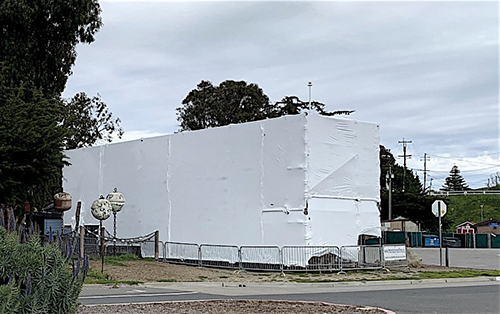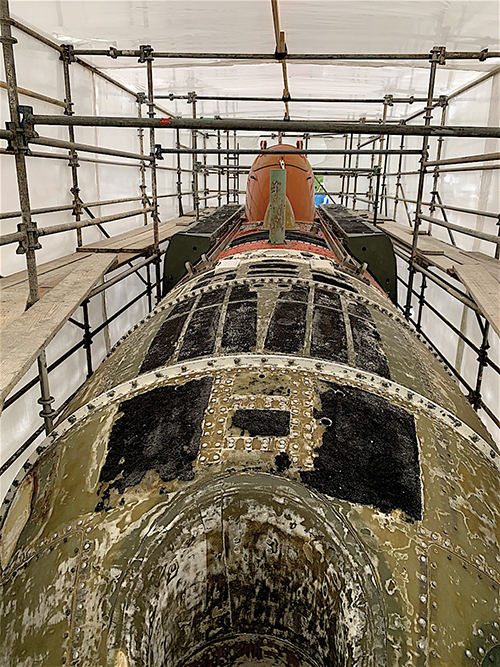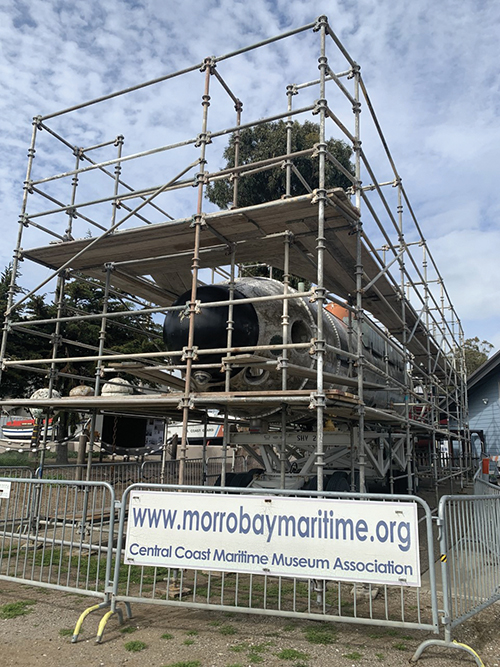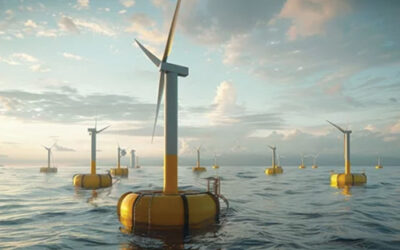Scaffolding was erected surrounding the DSRV Avalon to ready her for maintenance and painting. Photos courtesy Scott Mather
When your submarine needs a paint job, who you gonna call?
If you said a boat painter, you’d be right on the nose. The Morro Bay Maritime Museum Association’s signature exhibit — the Deep Submergence Rescue Vehicle (DSRV) Avalon on loan from the Navy since 2016 — was looking a bit scruffy and in need of maintenance.
But the Avalon is 49-feet long and weighs 37-tons, so you can’t just hook up the trailer and tow it to Earl Scheib. It takes special paint, equipment and perhaps most notably to the public, a paint booth to capture and control the paint fumes.
They had to bring in a man with experience. “We contracted with Bill Haynes,” said MBMMA President Scott Mather. “He is currently a vessel painter and commercial fisherman from Coos Bay, Oregon.”
Haynes used to be based locally. “He previously commercially fished out of and painted many local boats here in Morro Bay,” Mather said. “He is a Journeyman mil-spec painter who worked for many of the largest shipyards in the Los Angeles Area.” Mil-spec is short for paints that meet military specifications.
He’s also worked in Southern California shipyards, Mather explained, including San Pedro Boatworks, Southwest Marine, and Long Beach Naval Shipyard. He has experience painting in dry dock, which is what has to be done with the Avalon.
“He has experience in repair and restoration in Naval Dry Docks, LCM’s [Landing Craft Mechanized], LSD’s [Dock Landing Ship], LST’s [Landing Ship Tank], and Naval Frigates. He was also the foreman in the painting of Bob Hannel’s [founder of Los Angeles based Custom Lithographs] experimental TransPac catamaran, ‘Double Bullet II,’ working with high density foam, carbon fiber, epoxy resin, and linear polyurethane finishes.”

The Avalon’s green paint has faded in the sun and Mather said they owed it to the Navy to maintain the Avalon. “This is part of the Morro Bay Maritime Museum’s restoration projects,” Mather said. “The DSRV Avalon is on loan to the museum from the U.S. Navy History and Heritage Command. Being the curator and stewards of such an important artifact we have an obligation to the Navy to maintain it.”
The Navy doesn’t set up a maintenance schedule or anything like that. “They do not specify procedures or timelines,” Mather said. “We sent them our scope of work plan and they approved it. We send the Naval History and Heritage Command an annual report with photos of their property.”
With the work having to be done where the Avalon sits, it meant bringing a “paint booth” to the submarine. Scaffolding was erected surrounding the Avalon and just last week after waiting out the rain, the scaffolding was wrapped in shrink-wrap plastic and treated with a propane heat gun forming a sort of cocoon around the ship.
This way it can be painted and not have to worry about escaping fumes. It also means Haynes will have to use self-contained breathing gear while working under the plastic.
“This will give us the ability to control our painting environment by keeping the sub dry,” Mather explained. “Any debris will be contained and cleaned up daily. We estimate prep, paint, and cure time to take eight weeks.”

The paint is a special type and is rolled on, not sprayed. “Bill will be applying two ‘barrier coats’ of Awl Grip Epoxy Primers and three final coats of Awl Grip Linear Poly Urethane. This paint is used in the aviation industry and other commercial applications. This paint application is expected to last 20 years out in the elements.”
The MBMMA got a grant to pay for the Avalon’s restoration. “The grant is for $100,000,” Mather said, “from the Ludwick Foundation of SLO. Any remaining money will be used for more permanent mounting [getting the weight off the tires] and better fencing.”
The Avalon, which can carry 29, is open for viewing but the public isn’t allowed to climb up inside except on special occasions.
It should be noted that the Avalon is one of two DSRVs the Navy built in the early 1970s following the sinking of the USS Thresher, a nuclear attack submarine that was lost in April 1963 about 220-miles off Cape Cod, Mass., while conducting sea trials before being put into service.
USS Thresher sank with 129 sailors and shipyard workers aboard, all were lost.
The Avalon and her sister DSRV-1 Mystic were designed to be loaded onto a transport aircraft and flown anywhere in the world for missions to rescue sailors from sunken subs.
It was rated to dive to 5,000-feet deep and be able to merge with a sunken submarine’s hatch to rescue the crew. Neither the Avalon nor the Mystic were actually used for a rescue. Both are now decommissioned and on public display — Avalon in Morro Bay and Mystic at the U.S. Naval Undersea Museum located in Keyport, Wash.
Mystic was launched in 1970 and was decommissioned in 2008. The Avalon was launched in 1971, and decommissioned in 2000.
And the story of the Avalon is being told by Mather’s wife Lori a documentary filmmaker who also produced a film about Morro Bay’s history with the abalone industry.
Lori Mather, “just finished three new short videos that are playing in our small theater,” Scott said. “They are on the DSRV. 1. What is it? 2. What do submarines have to do with MB Maritime History? 3. A chilling tale from a Navy oceanographer who was in it when it lost power and sank to the bottom off Pt. Sur.”
Mather said the videos teach about “the connection between the Apollo Moon Landing and the DSRV Avalon, and how they shaped every computer we have today. These videos are 5-minutes long and full of fascinating information. Everyone should come down and watch them.”
The Morro Bay Maritime Museum is located at 1210 Embarcadero and open Thursdays-Mondays from 10 a.m. to 3 p.m. Admission is free and they have a gift shop inside the museum exhibit building.
The Museum has several historic vessels and displays of maritime artifacts — from an early dive compressor to a whaling harpoon and whale oil cauldron, antique cannon, and even a bathysphere.




